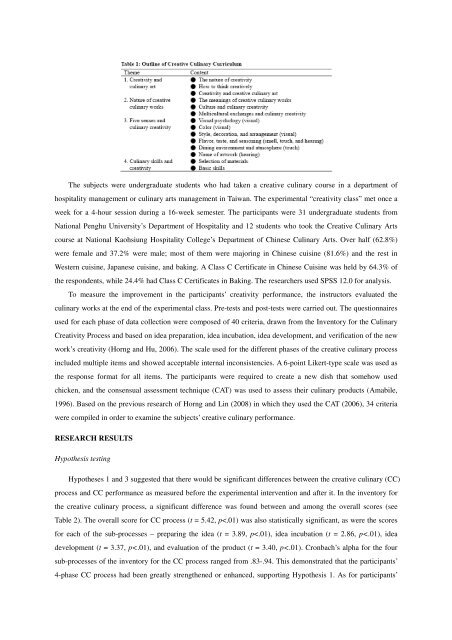THE IMPACT OF THE CREATIVE CULINARY CURRICULUM ON ...
THE IMPACT OF THE CREATIVE CULINARY CURRICULUM ON ...
THE IMPACT OF THE CREATIVE CULINARY CURRICULUM ON ...
You also want an ePaper? Increase the reach of your titles
YUMPU automatically turns print PDFs into web optimized ePapers that Google loves.
The subjects were undergraduate students who had taken a creative culinary course in a department ofhospitality management or culinary arts management in Taiwan. The experimental “creativity class” met once aweek for a 4-hour session during a 16-week semester. The participants were 31 undergraduate students fromNational Penghu University’s Department of Hospitality and 12 students who took the Creative Culinary Artscourse at National Kaohsiung Hospitality College’s Department of Chinese Culinary Arts. Over half (62.8%)were female and 37.2% were male; most of them were majoring in Chinese cuisine (81.6%) and the rest inWestern cuisine, Japanese cuisine, and baking. A Class C Certificate in Chinese Cuisine was held by 64.3% ofthe respondents, while 24.4% had Class C Certificates in Baking. The researchers used SPSS 12.0 for analysis.To measure the improvement in the participants’ creativity performance, the instructors evaluated theculinary works at the end of the experimental class. Pre-tests and post-tests were carried out. The questionnairesused for each phase of data collection were composed of 40 criteria, drawn from the Inventory for the CulinaryCreativity Process and based on idea preparation, idea incubation, idea development, and verification of the newwork’s creativity (Horng and Hu, 2006). The scale used for the different phases of the creative culinary processincluded multiple items and showed acceptable internal inconsistencies. A 6-point Likert-type scale was used asthe response format for all items. The participants were required to create a new dish that somehow usedchicken, and the consensual assessment technique (CAT) was used to assess their culinary products (Amabile,1996). Based on the previous research of Horng and Lin (2008) in which they used the CAT (2006), 34 criteriawere compiled in order to examine the subjects’ creative culinary performance.RESEARCH RESULTSHypothesis testingHypotheses 1 and 3 suggested that there would be significant differences between the creative culinary (CC)process and CC performance as measured before the experimental intervention and after it. In the inventory forthe creative culinary process, a significant difference was found between and among the overall scores (seeTable 2). The overall score for CC process (t = 5.42, p
















